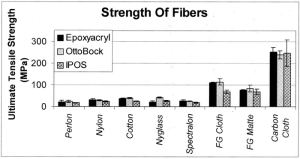Fiber-Reinforced Composites
Fiber-reinforced composite (FRC) materials are composed of two or more mechanically separable materials with unique properties:
- Fiber: Typical fiber materials used in P&O include carbon, Kevlar, dyneema
- Matrix: Typical resins used in P&O include epoxy and acrylic.
The factors that affect the specific strength properties of a FRC include:

1. Fiber Properties
- Fiber strength and modulus (stiffness): Higher-strength fibers (like carbon or aramid) directly improve composite strength.
- Carbon fiber is always stiffer than fiberglass.
- The figure (Strength of Fibers) shows the ultimate tensile strength of composites using three resins with eight different fibers.
- Fiber length and aspect ratio: Longer fibers provide better load transfer and higher strength
- Higher aspect ratios allow better stress transfer from the matrix to the fiber
- Longer fibers can carry loads over greater distances within the composite
- Short fibers with low aspect ratios may pull out of the matrix before reaching their full strength potential
- Fiber diameter: Smaller diameter fibers typically have fewer defects and higher strength
2. Matrix (i.e., resin) Properties
- Matrix strength and toughness: Affects load transfer between fibers and overall composite behavior
- Epoxy resin is the strongest of the resins listed in the table below.
- Acrylic is a thermoplastic, meaning its use is beneficial if you expect to make heat modifications after lamination.
- Matrix-fiber compatibility: Chemical and thermal compatibility influences interfacial bonding
- Matrix processing characteristics: Viscosity and cure behavior affect fiber wet-out and void content
Resins hold the base materials in the correct alignment, but are not a significant source of strength. They provide rigidity and dimensional stability. Table 1 describes some of the basic qualities of some common resins used in prosthetics and orthotics. There are various types of resins – rigid, flexible, and elastomeric.
| Resin Type | Bond | Volatile Organic Compounds (VOC) Exposure | Sensitizer | Set-formable | Sensitive to | Expense |
| Polyester | Mechanical | High | Thermoset | Not much | Less | |
| Acrylic | Low | Thermoplastic | Air and water | More | ||
| Epoxy | Chemical | Low | Yes | Thermoset | Proportions | More |
| Epoxacryl | Low | Thermoset | Even More |
3. Interface/Interphase
- Bond strength: Critical for load transfer from matrix to fibers
- Interface chemistry: Affects adhesion and compatibility between phases
- Sizing and surface treatments: Coatings on fibers can optimize interfacial properties
4. Fiber Architecture and Manufacturing Factors
- Fiber orientation (unidirectional or weave pattern): Fibers provide maximum strength in the fiber direction.
- Layup sequence and distribution: Stacking sequence affects overall strength properties.
- The layup refers to the number and type of fiber as well as the placement of the various materials. The fiber ‘layup’ provides reinforcement and mechanical strength; it varies according to the needs of the patient with regard to the patient’s weight and activity level.
- Place the strongest fibers at areas that require the highest amount of strength.
- Avoid placing fibers in areas where you will be trimming or grinding. Please observe safety precautions as many of these materials are hazardous to the respiratory system (use respirator when grinding) and are irritants to touch.
- Processing temperature and pressure: Affects consolidation and void content
- Cure conditions: Proper curing ensures optimal matrix properties
- Void content: Porosity reduces strength significantly
- Fiber volume fraction: Higher fiber content, relative to resin, generally increases strength up to an optimal point
5. Environmental Considerations
- Temperature: Affects matrix properties and fiber-matrix interface
- Moisture absorption: Can degrade matrix and interface properties
- Chemical exposure: May cause degradation of fibers or matrix
- Avoid cleaning laminated socket with acetone. Acetone can cause swelling, softening, or degradation of the matrix and may create micro-cracks or surface roughening. Use isopropyl alcohol, mild soap and water, or specialized degreasers (e.g., aviation or automotive products) designed for composite parts.
Fiber-Reinforced Composites (FRC) – Key Takeaways
- FRC are strongest in tension and weakest in shear and compression. Compression stress is negligible in metals, but important in FRC.
- In bending, materials weak in shear (e.g., FRC) most likely fail at the neutral plane.
- Carbon has higher stiffness than glass fiber.
- Thermoset (epoxy) is stronger than thermoplastic (acrylic).
- Specific strength properties of FRC materials are based on the fiber strength and stiffness, fiber length, matrix strength and toughness, fiber orientation, and layup sequence and distribution.
- After lamination, when cleaning, use isopropyl alcohol, mild soap and water, or specialized degreasers (e.g., aviation or automotive products) designed for composite parts.
References
Phillips SL, Craelius W. Material Properties of Selected Prosthetic Laminates. JPO 17(1):p 27-32, January 2005.
Klasson BL. Carbon Fibre and Fibre Lamination in Prosthetics and Orthotics: Some Basic Theory and Practical Advice for the Practitioner. POI. 1995;19:74-91. This article has some examples of various layups. It also explains a little about how the weight of carbon braid and the angle of weave influence the layup.
a material composed of two or more mechanically separable materials with unique properties that are superior to those of the individual constituent parts
The specific strength is a material's strength divided by its density. It is also known as the strength-to-weight ratio or strength/weight ratio or strength-to-mass ratio.
Fiber aspect ratio is the ratio of a fiber's length to its diameter (or width for non-circular cross-sections). It's expressed as:
Aspect Ratio = Length / Diameter (L/d)
Ratio of fiber to resin
